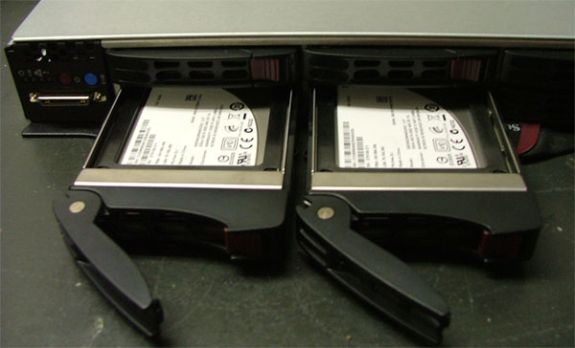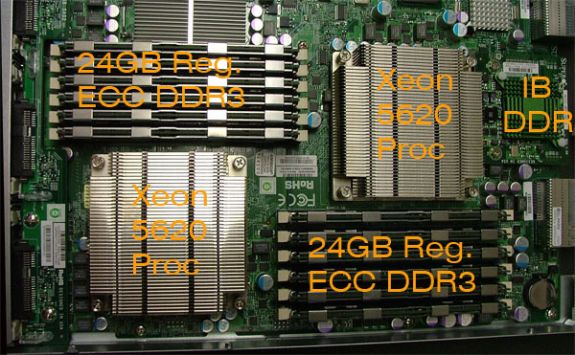ZFS - Building, Testing, and Benchmarking
by Matt Breitbach on October 5, 2010 4:33 PM EST- Posted in
- IT Computing
- Linux
- NAS
- Nexenta
- ZFS
Test Blade Configuration
Our bladecenters are full of high performance blades that we use to run a virtualized hosting environment at this time. Since the blades that are in those systems are in production, we couldn’t very well use them to test the performance of our ZFS system. As such, we had to build another blade. We wanted the blade to be similar in spec to the blades that we were using, but we also wanted to utilize some of the new technology that has come out since we put many of our blades into production. Our current environment is mixed with blades that are running Dual Xeon 5420 processors w/ 32GB
Following that tradition we decided to use the SuperMicro SBI-7126T-S6 as our base blade. We populated it with Dual Xeon 5620 processors (Intel Xeon Nehalem/Westmere based 32nm quad core), 48GB Registered
Front panel of the SBI-7126T-S6 Blade Module
Intel X25-V
Dual Xeon 5620 processors, 48GB Registered
Our tests will be run using Windows 2008R2 and Iometer. We will be testing iSCSI connections over gigabit Ethernet, as this is what most budget
Price OpenSolaris box
The OpenSolaris box, as tested was quite inexpensive for the amount of hardware added to it. Overall costs for the OpenSolaris system was $6765. The breakdown is here :
|
Part |
Number |
Cost |
Total |
|
1 |
$1,199.00 |
$1,199.00 |
|
|
2 |
$166.00 |
$332.00 |
|
|
1 |
$379.00 |
$379.00 |
|
|
1 |
$253.00 |
$253.00 |
|
|
2 |
$378.00 |
$756.00 |
|
|
2 |
$414.00 |
$828.00 |
|
|
2 |
$109.00 |
$218.00 |
|
|
20 |
$140.00 |
$2,800.00 |
|
|
Total |
|
|
$6,765.00 |
Price of Nexenta
While OpenSolaris is completely free, Nexenta is a bit different, as there are software costs to consider when building a Nexenta system. There are three versions of Nexenta you can choose from if you decide to use Nexenta instead of OpenSolaris. The first is Nexenta Core Platform, which allows unlimited storage, but does not have the GUI interface. The second is Nexenta Community Edition, which supports up to 12TB of storage and a subset of the features. The third is their high end solution, Nexenta Enterprise. Nexenta Enterprise is a paid-for product that has a broad feature set and support, accompanied by a price tag.
The hardware costs for the Nexenta system are identical to the OpenSolaris system. We opted for the trial Enterprise license for testing (unlimited storage, 45 days) as we have 18TB of billable storage. Nexenta charges you based on the number of TB that you have in your storage array. As configured the Nexenta license for our system would cost $3090, bringing the total cost of a Nexenta Enterprise licensed system to $9855.
Price of Promise box
The Promise M610i is relatively simple to calculate costs on. You have the cost of the chassis, and the cost of the drives. The breakdown of those costs is below.
|
Part |
Number |
Cost |
Total |
|
1 |
4170 |
$4,170.00 |
|
|
16 |
$140.00 |
$2,240.00 |
|
|
Total |
|
|
$6,410.00 |
How we tested with Iometer
Our tests are all run from Iometer, using a custom configuration of Iometer. The .icf configuration file can be found here. We ran the following tests, starting at a queue depth of 9, ending with a queue depth of 33, stepping by a queue depth of 3. This allows us to run tests starting below a queue depth of 1 per drive, to a queue depth of around 2 per drive (depending on the storage system being tested).
The tests were run in this order, and each test was run for 3 minutes at each queue depth.
4k Sequential Read
4k Random Write
4k Random 67% write 33% read
4k Random Read
8k Random Read
8k Sequential Read
8k Random Write
8k Random 67% Write 33% Read
16k Random 67% Write 33% Read
16k Random Write
16k Sequential Read
16k Random Read
32k Random 67% Write 33% Read
32k Random Read
32k Sequential Read
32k Random Write
These tests were not organized in any particular order to bias the tests. We created the profile, and then ran it against each system. Before testing, a 300GB iSCSI target was created on each system. Once the iSCSI target was created, it was formatted with NTFS defaults, and then Iometer was started. Iometer created a 25GB working set, and then started running the tests.
While running these tests, bear in mind that the longer the tests run, the better the performance should be on the OpenSolaris and Nexenta systems. This is due to the L2ARC caching. The L2ARC populates slowly to reduce the amount of wear on MLC













102 Comments
View All Comments
L. - Wednesday, March 16, 2011 - link
Too bad you already have the 15k drives.2) I wanted to say this earlier, but I'm quite confident that SLC is NOT required for a SLOG device, as with current wear leveling, unless you actually write more than <MLC disk capacity> / day there is no way you'll ever need the SLC's extended durability.
3) Again, MLC SSD's, good stuff
4) Yes again
5) not too shabby
6) Why use 15k or 7k2 rpm drives in the first place
All in all nice project, just too bad you have to start from used equipment.
In my view, you can easily trash both your similar system and Anandtech's test system and simply go for what the future is going to be anyway :
Raid-10 MLC drives, 48+RAM, 4 CPU's (yes those MLC's are going to perform so much faster you will need this - quite a fair chance you'll need AMD stuff on that as 4-socket is their place) and mainly and this is the hardest part, sata 6 Gb/s * many with a controller that can actually handle the bandwidth.
Overall you'd get a much simpler, faster and cleaner solution (might need to upgrade your networking though to match with the rest).
L. - Wednesday, March 16, 2011 - link
Of course, 6 months later .. .its not the same equation ;) Sorry for the necroB3an - Tuesday, October 5, 2010 - link
I like seeing stuff like this on Anand. It's a shame it dont draw as much interest as even the poor Apple articles.Tros - Tuesday, October 5, 2010 - link
Actually, I was just hoping to see a ZFS vs HFS+ comparison for the higher-end Macs. But with the given players (Oracle, Apple), I don't know if the drivers will ever be officially released.Taft12 - Wednesday, October 6, 2010 - link
Doesn't it? This interests me greatly and judging by the number of comments is as popular as any article about the latest video or desktop CPU techgreenguy - Wednesday, October 6, 2010 - link
I have to say, kudos to you Anand for featuring an article about ZFS! It is truly the killer app for filesystems right now, and nothing else is going to come close to it for quite some time. What use is performance if you can't automatically verify that your data (and the system files that tells your system how to manipulate that data) was what it was the last time you checked?You picked up on the benefits of the SSD (low latency) before anyone else, it is no wonder you've figured out the benefits of ZFS too earlier than most of your compatriots as well. Well done.
elopescardozo - Tuesday, October 5, 2010 - link
Hi Matt,Thank you for the extensive report. In your testing results there are a few unexpected results. I find the difference between Nexenta and Open Solaris hard to understand, unless it is due to misalignment of the IO in the case of Nexenta.
A zvol (the basis for an iSCSI volume) is created on top of the ZFS pool with a certain block size. I believe the default is 8kB. Next you initialize the volume and format it with NTFS. By default the NTFS structure starts at sector 63 (sixty three, not a typo!), which means that every other 4kB cluster (the NTFS allocation size) falls over a zvol block boundary. That has a serious impact on performance. I saw a report of 70% improvement after properly alignment.
Is it possible that the Open Solaris and Nexenta pools were different in this respect, either because of different zvol block size (e.g. 8kB for Nexenta, 128kB for Open Solaris – larger blocks means less “boundary cases”) or differences in how the volumes were initialized and formatted?
mbreitba - Tuesday, October 5, 2010 - link
It's possible that the sector alignment could be a problem, but I believe the build that we tested, the default sector size was set to 128kB, which was identical to OpenSolaris. If that has changed, then we should re-test with the newest build to see if that makes any differences.cdillon - Tuesday, October 5, 2010 - link
Windows Server 2008 aligns all newly created partitions at 1MB, so his NTFS block access should have been properly aligned by default.Mattbreitbach - Tuesday, October 5, 2010 - link
I was unaware that Windows 2008 correctly aligned NTFS partitions now. Thanks for the info!